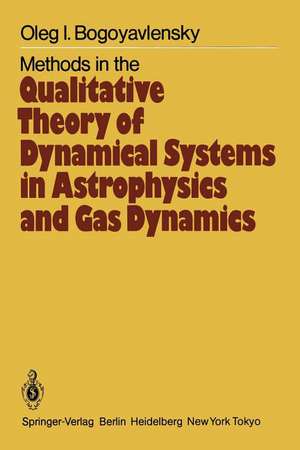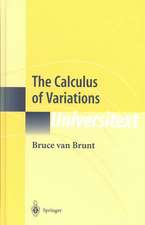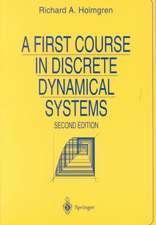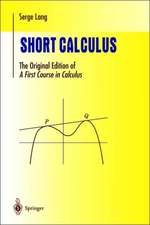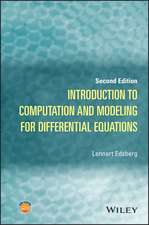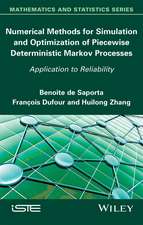Methods in the Qualitative Theory of Dynamical Systems in Astrophysics and Gas Dynamics: Springer Series in Soviet Mathematics
Autor O.I. Bogoyavlensky Traducere de D. Gokhmanen Limba Engleză Paperback – 12 oct 2011
Preț: 388.34 lei
Nou
Puncte Express: 583
Preț estimativ în valută:
74.32€ • 77.15$ • 61.97£
74.32€ • 77.15$ • 61.97£
Carte tipărită la comandă
Livrare economică 22 martie-05 aprilie
Preluare comenzi: 021 569.72.76
Specificații
ISBN-13: 9783642649028
ISBN-10: 3642649025
Pagini: 316
Ilustrații: IX, 301 p.
Dimensiuni: 152 x 229 x 17 mm
Greutate: 0.42 kg
Ediția:Softcover reprint of the original 1st ed. 1985
Editura: Springer Berlin, Heidelberg
Colecția Springer
Seria Springer Series in Soviet Mathematics
Locul publicării:Berlin, Heidelberg, Germany
ISBN-10: 3642649025
Pagini: 316
Ilustrații: IX, 301 p.
Dimensiuni: 152 x 229 x 17 mm
Greutate: 0.42 kg
Ediția:Softcover reprint of the original 1st ed. 1985
Editura: Springer Berlin, Heidelberg
Colecția Springer
Seria Springer Series in Soviet Mathematics
Locul publicării:Berlin, Heidelberg, Germany
Public țintă
ResearchCuprins
I. Methods of Qualitative Analysis of Multi-Dimensional Dynamical Systems.- 1. Prerequisites from the Qualitative Theory of Two-Dimensional Dynamical Systems.- 2. Analysis of Degenerate Critical Points of a Dynamical System.- 3. Maximally Non-Degenerate Compactification of a Dynamical System.- 4. Separatrix Approximation Method for the Trajectories of a Dynamical System.- II. Qualitative Theory of Homogeneous Cosmological Models Without the Motion of Matter.- 1. Equations of the General Theory of Relativity.- 2. Classical Solutions to the Equations of the General Theory of Relativity.- 3. General Properties of Homogeneous Cosmological Models.- 4. Transformation of the Hamiltonian System.- 5. Cosmological Models of Types I and II.- 6. Cosmological Models of Type IX.- 7. Analysis of Cosmological Models of Types VIII, VII0 and V10.- 8. Transformation of the Dynamical System for Homogeneous Cosmological Models of Class B.- 9. Several General Properties of the Dynamics of Homogeneous Cosmological Models of Types III, IV, VI and VII.- 10. Analysis of Several Special Properties of Homogeneous Cosmological Models of Types V, VII, III, VI and IV.- III. Qualitative Theory of Homogeneous Cosmological Models with the Motion of Matter and Electromagnetic Fields.- 1. Einstein’s System of Equations for the Homogeneous Cosmological Model of Type IX with the Motion of Matter.- 2. Transformation of the Dynamical System.- 3. Power Asymptotics. Typical States of the Metric in the Early Stages of the Expansion of Space.- 4. Combinatorial Model of the Oscillatory Mode.- 5. Several Common Properties of the Dynamics of Homogeneous Cosmological Models with the Motion of Matter.- 6. Homogeneous Cosmological Model of Type IX with Electromagnetic Fields.- IV. Self-Similar Spherically SymmetricSolutions for the General Theory of Relativity.- 1. Einstein’s System of Equations for Spherically Symmetric Self-Similar Solutions.- 2. Analysis of the Dynamical System.- 3. Transformation of Self-Similar Solutions in Various Coordinates.- 4. The Problem of Breakdown of Equilibrium of a Star in the General Theory of Relativity.- 5. Self-Similar Solutions with Expanding and Converging Shock Waves.- V. Self-Similar Motion of Self-Gravitating Gas in Stars.- 1. Resolution of Singularities of the Dynamical System.- 2. Asymptotics of Gas Moving Away from the Center.- 3. Analysis of the Dynamical System on the Components of the Boundary ?2 and ?8.- 4. Self-Similar Accretion of Self-Gravitating Gas to the Center.- 5. New Solutions in the Model of Stellar Explosions.- 6. Analysis of Models of Explosions in Stellar Envelopes.- 7. Self-Similar Solutions with Converging Shock Waves.- VI. Self-Similar Rotation of an Ideal Gas.- 1. Definition of Self-Similar Rotation of an Ideal Gas.- 2. Algebraic Integrals for the Self-Similar Rotation of an Ideal Gas.- 3. Exact Self-Similar Power Solutions.- 4. Analysis of the Dynamical System.- 5. Self-Similar Expansion of Rotating Gas.- 6. Several Self-Similar Solutions with ? = 2.- VII. The Dynamics of a Gaseous Ellipsoid.- 1. Equations of Motion of a Non-Gravitating Gaseous Ellipsoid.- 2. Oscillatory Mode of Expansion of a Rotating Gas Cloud into Vacuum.- 3. Analysis of a Problem in the Theory of Shallow Water.- 4. Equations of Motion of a Gravitating Gaseous Ellipsoid.- 5. Transformation of the Hamiltonian System.- 6. Oscillatory Mode of Motion with Negative Energy.- 7. On the Impossibility of Collapse of a Gravitating Gaseous Ellipsoid in the Presence of Rotation of the Gas.- 8. Oscillatory Mode of Motion with Positive Energy.- 9.Concluding Remarks.- VIII. The Dynamics of Perturbations of the Periodic Toda Lattice.- 1. Hamiltonian Perturbations of the Toda Lattice.- 2. Separatrix Approximation of the Oscillatory Mode.- 3. Hamiltonian Systems Connected with Simple Lie Algebras.- 4. Non-Linear Oscillatory Modes in Systems of Hydrodynamical Type.
